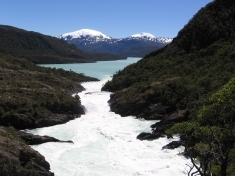Basic Facts: Baker & Pascua Rivers, Proposed Dams and Transmission Lines
Basic facts about the dams and the rivers:
1. Five total hydroelectric dams are planned, three for the Pascua River and two for the Baker River. Some of these dams would be more than 2,450 kilometers (1,500 miles) from the central grid to which the electricity will be sent. Both rivers are fed by, and they flow in between, the world’s two largest ice caps outside Greenland and Antarctica. And they are relatively short in length, 170 kilometers for the Baker and only 62 kilometers (40 miles) for the Pascua.
2. The Baker River has the highest flow of all Chilean rivers. Its ecosystem supports high levels of biodiversity, including documented populations of the endangered huemul deer1. Chilean environmental authorities have characterized the river’s entire basin as a biological corridor and have said that the Baker River’s conservation should be prioritized.
3. The Pascua River has the third highest flow of all Chilean rivers. Especially in its upper reaches, the Pascua river ecosystem includes some of Chile’s largest remaining populations of the endangered huemul deer. Some of these populations of huemul were documented by International Rivers firsthand in its recent expedition along the Pascua. Chilean environmental authorities have recognized the Pascua for high aquatic biodiversity, have characterized most of the river’s basin as a biological corridor and have said that this river’s conservation should be prioritized.
4. As currently planned, the two dams on the Baker River would create artificial lakes flooding more than 4,300 hectares (10,700 acres). Flooded lands would include some of the best agricultural and ranching lands of the region.
5. As currently planned, the three dams on the Pascua River would create artificial lakes flooding more than 1,600 hectares (4,000 acres). Flooded lands would include some of the world’s rarest forest types, including the critically endangered guaiteca cipres (pilgerodendron uviferum) . Other rare species that would be harmed by the Pascua dams include the torrent duck (merganetta armata) and the white-bellied seed-snipe (attagis malouinus).
Basic facts about the transmission lines:
1. The corridor for these would be one of the world’s longest between the source of the electricity and its primary distribution center. As currently planned, the distance would be more than 2,450 kilometers (1,500 miles).
2. As currently planned, the transmission line corridor would require clearcutting forested areas for at least 1,600 kilometers (1,000 miles) of the corridor’s total length. More than 5,000 transmission towers are planned, with each transmission tower at least 70 meters high. The transmission corridor will be 120 meters wide.
3. As currently planned, the route for transmission lines would traverse 64 Chilean "communas", including some indigenous communities, and would damage 14 areas that, because of unique environmental values and vulnerabilities, have been granted protected status under Chilean law.
1Chile’s huemul deer is classified as Endangered (EN C2a) on the IUCN Red List 2004 and is listed on Appendix I of CITES. It is also listed on Appendix I of the Convention on Migratory Species (CMS or Bonn Convention).



